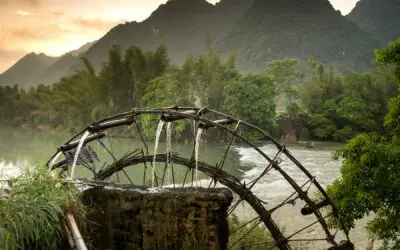Feeling the effects first hand, coffee farmers are implementing a multifaceted approach, adapting to climate change.
These adaptations combine traditional knowledge with innovative agricultural practices and global collaboration. They address rising temperatures, erratic rainfall, and increased pest pressures while maintaining production viability:
1. Geographic Shifts and Microclimate Management
- Farmers are relocating coffee plantations to higher elevations where cooler temperatures better suit Arabica varieties[1][4].
- Shade-grown coffee systems are being expanded, using tree canopies to reduce heat stress by 2-3°C and conserve soil moisture[1][5]. This approach also supports biodiversity and carbon sequestration.
2. Climate-Resilient Cultivation Practices
- Soil health improvements through organic fertilizers, cover crops, and conservation tillage enhance water retention and drought resilience[3][5][8].
- Precision irrigation systems and water harvesting techniques optimize scarce water resources[1][4].
- Integrated pest management combines biological controls with targeted pesticide use to combat climate-driven outbreaks of coffee leaf rust and berry borer[2][4].
3. Genetic Adaptation and Crop Diversification
- New hybrid varieties like Stenophylla and Centroamericano are being developed for heat/disease resistance while maintaining flavor profiles[1][7].
- Agroforestry systems integrate coffee with food crops (bananas, avocados) and timber species, providing income diversification and ecosystem benefits[5][8].
4. Structural Support and Collaborative Programs
- Initiatives like Conservation International’s AROMA program ($120M) promote regenerative agriculture across four key producing countries through:
- Climate-resilient agroforestry models
- Farmer training networks
- Deforestation reduction strategies[6]
- Climate Impact Chain analysis helps prioritize site-specific interventions through vulnerability mapping of 90% global production areas[10].
Challenges and Emerging Needs
While 74% of surveyed farmers report improved resilience from these measures[4], systemic barriers persist:
- Financial constraints limit smallholders’ ability to implement costly adaptations
- Data gaps in long-term impact monitoring hinder optimization
- Land scarcity complicates elevation shifts in mountainous regions
Ongoing research focuses on predictive modeling for 2050 climate scenarios[7] and developing financial mechanisms to scale proven adaptation strategies[10]. The sector’s success now hinges on aligning producer-level adaptations with broader supply chain commitments to climate-smart sourcing practices[6][9].
Do you live in a coffee region affected by climate change? If so, I’d love to hear about the changes you have experienced first hand. Maybe it is becoming increasingly difficult to cultivate, or maybe coffee is becoming a viable cash crop for you. Either way, drop us a note in the comments. Also, be sure to take a moment (literally) to friend, follow, share and subscribe to The Coffee Authority Weekly because we are all better for the community we build.



0 Comments